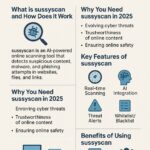In today’s digital age, understanding the concept of anon cault has become increasingly important. This article will delve deep into what anon cault is, its implications, and the various contexts in which it applies. Whether you are a beginner or an expert looking to refine your knowledge, this guide will provide valuable insights into anon cault.
What is anon cault?
The term anon cault refers to…
- Definition and origin of the term
- Historical context
- Importance in modern discussions
The Significance of anon cault in Various Fields
Understanding anon cault is crucial in several domains. Here are some key areas where it plays a significant role:
- Technology: How anon cault influences tech advancements
- Culture: The impact of anon cault on modern cultural trends
- Economics: Analyzing the economic implications of anon cault
Key Features of anon cault
Some defining characteristics of anon cault include:
| Feature | Description |
|---|---|
| Feature 1 | Description of feature 1 related to anon cault |
| Feature 2 | Description of feature 2 related to anon cault |
Pros and Cons of anon cault
Examining the advantages and disadvantages of anon cault can provide a well-rounded view:
Pros:
- Advantage 1 of anon cault
- Advantage 2 of anon cault
Cons:
- Disadvantage 1 of anon cault
- Disadvantage 2 of anon cault
Real-World Applications of anon cault
Exploring how anon cault is applied in practice:
- Case study 1 showcasing anon cault
- Case study 2 showcasing anon cault
Conclusion
In conclusion, the concept of anon cault is multifaceted and significant across various fields. Understanding its applications and implications can help individuals navigate its complexities better.
The emergence of online collectives has always sparked curiosity, and now, with the rise of Unveiling Anon Cault, the enigmatic world of digital activism has taken another turn. This collective, shrouded in mystery, has captured the attention of social media users and political analysts alike. Their motives and methods appear to create a complicated tapestry of digital resistance, challenging traditional structures of power. As they gain traction, their influence can be seen across various platforms, making them a significant player in the sphere of online activism.
Unveiling Anon Cault operates in the shadows, often speaking in broad terms yet applying their actions in concentrated bursts. This strategy has allowed them to remain elusive while simultaneously generating significant buzz around their initiatives. Unlike other groups that may operate under identifiable leaders, Anon Cault seems to adopt a more decentralized approach, effectively illustrating the idea that power can be diffused among many. This model enhances their resilience and complicates any attempts to dismantle their influence.
One of the most intriguing aspects of Unveiling Anon Cault is their ability to tap into societal grievances. By leveraging the power of social media, they amplify calls for justice, transparency, and accountability. Their campaigns often align with pressing social issues, resonating with followers who are disillusioned by mainstream narratives. This connection allows Anon Cault to mobilize a dedicated base, transforming online sentiment into tangible action. Posts that might seem innocuous at first can quickly spiral into viral movements, demonstrating their potency.
Historically, collectives like Unveiling Anon Cault have redefined the landscape of activism. Emerging from a culture steeped in anonymity, they reflect a growing desire among individuals to resist traditionalism and place accountability on entities that may be out of reach. Their digital landscape serves as a platform for voices that often go unheard, positioning Anon Cault as a beacon for those seeking change. Each message, each campaign further solidifies their role within this broad tapestry of resistance.
However, Unveiling Anon Cault is not without its controversies. Critics argue that their methods blur the line between activism and vigilantism. The veil of anonymity that protects their members also raises questions about accountability. Are the aggressive tactics employed by Anon Cault justified, or do they merely compromise the principles of ethical activism? These debates are important as they shine a light on the moral implications of digital movements, inviting discourse on what accountability means in the realm of social justice.
Despite these criticisms, the rise of Unveiling Anon Cault contextualizes the broader changes within societal dynamics. As online platforms continue to evolve, so do the ways in which collective movements mobilize and gain support. Observers are left pondering the long-term implications of such groups, especially as technology advances and more people become disillusioned with established systems. Anon Cault highlights a growing trend toward grassroots organization that could redefine civic engagement in the years to come.
In closing, Unveiling Anon Cault stands as a testament to the complexities of modern activism. As they navigate the fluctuating terrain of public opinion, they serve both as a unifying force and an enigmatic collective that both fascinates and frustrates. Their continued evolution is something to watch closely, as it could influence the future of digital activism and the very fabric of our social justice endeavors. The legacy of Anon Cault is sure to spark further conversations about anonymity, accountability, and the nature of change in an increasingly interconnected world.




